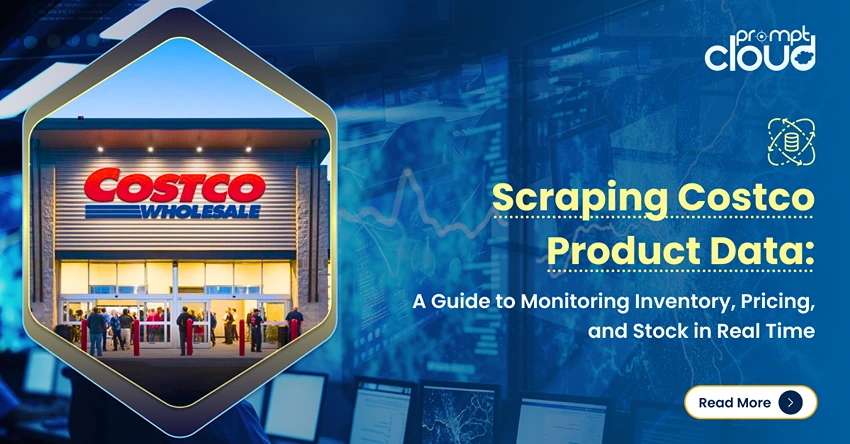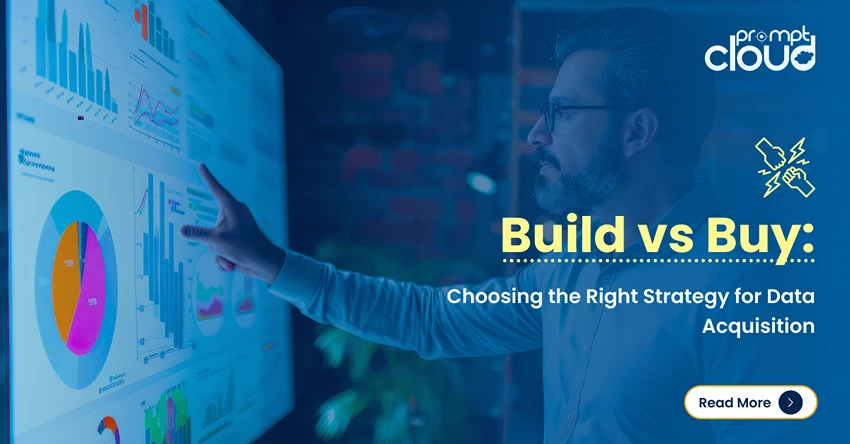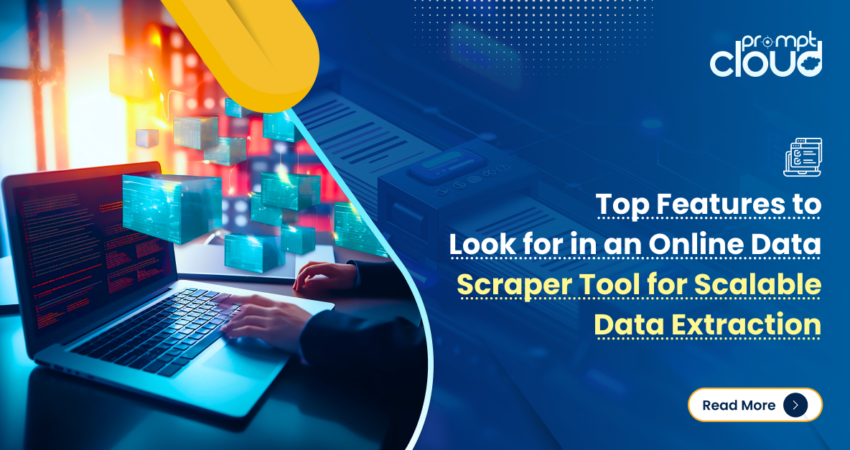
No matter what sort of data you’re after, the internet is filled with valuable data. But to extract it efficiently, you need the right data scraper tool. If you are a market researcher, business intelligence analyst, or part of an enterprise looking to scale data collection, picking the correct online data scraper tool will greatly impact the speed and accuracy of your insights collection.
There are countless data scraper tools in the market today. This naturally brings the question: how do you know which one is the best for your specific needs? This guide helps you identify the most important features for an instant data scraper and make sure that the tool you pick is efficient, reliable, and, most importantly, scalable.
What is a Data Scraper Tool?
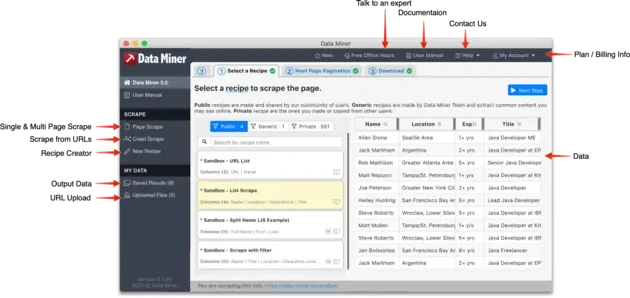
Image Source: Dataminer
A data scraper tool is an application that eases the work of collecting data from online sources. A data scraper tool saves time by removing the need to manually copy data from web pages. The tool instead scans the data on the web pages, saves the relevant data, and saves the data in a file such as CSV, JSON, or a database.
Data scraper tools are being used around the world because the tools help in organizing the data from the internet. Product prices, customer reviews, social media analytics, and financial reports are just some of the useful pieces of information that a data scraper tool can collect swiftly and accurately.
There are different types of online data scraper tools, including:
- Instant Data Scraper Tools – Allows users to extract data without prior configuration through a web browser.
- Cloud-Based Scrapers – These are remote solutions that run on its own, carrying out large-scale extractions effortlessly while not straining the host computer’s resources.
- Custom Web Scrapers – Custom-made scrapers based on specific business requirements designed to target specific data.
The best scraper tools available help businesses automate the retrieval of large amounts of web data with minimal manual work involved.
Why Businesses Need a Data Scraper Tool
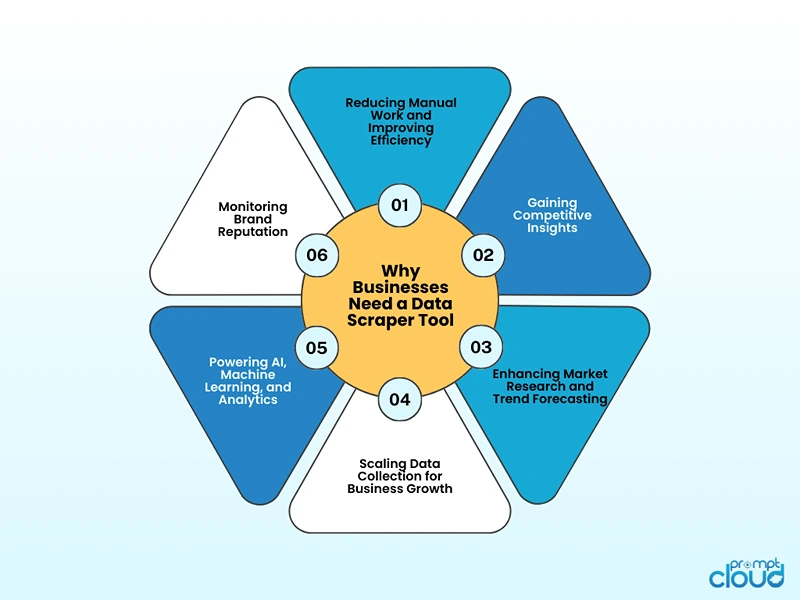
In the highly competitive world we live in, real-time insights are critical to outperforming the competition. Every organization has numerous untapped data sources spread all over the web, and a scraper tool helps them to harvest this web data for further analysis.
1. Reducing Manual Work and Improving Efficiency
Gathering data manually is labor-intensive and prone to errors. A data scraper tool helps automate this task. Businesses are now capable of retrieving large datasets in a matter of seconds instead of hours or days. Teams can shift to focusing on analyzing data rather than spending time collecting it.
2. Gaining Competitive Insights
Scraper tools are used by many companies to monitor changes in their competitors’ strategy, pricing, or products on offer. Businesses are now able to make better pricing adjustments, marketing strategy improvements, and smarter inventory control decisions with access to competitor data.
3. Enhancing Market Research and Trend Forecasting
Businesses have to be aware of industry changes, customer tastes and preferences, and new technologies. A data scraper tool is capable of collecting information from:
- News sites to track market shifts.
- Social media to analyze brand sentiment.
- Review platforms to understand consumer expectations.
This allows businesses to make decisions based on factual data as opposed to making assumptions.
4. Scaling Data Collection for Business Growth
Data requirements change at a drastically greater rate than the pace of company growth. A scalable cloud data scraper tool can scrape millions of pages from the web without affecting functionality, ensuring businesses have access to fresh and high-quality data.
5. Powering AI, Machine Learning, and Analytics
Companies using AI and machine learning require data of the highest quality. The data scraper tool offers all the required raw data to train organization models, build automation systems, and refine user-specific offerings.
6. Monitoring Brand Reputation
Businesses need instant data scraper tools for monitoring customer feedback, digital conversations, and the overall perception of a brand. This helps businesses mitigate issues that can damage the reputation of an organization.
With a data scraper tool, organizations are better positioned to access real-time information, making it easier to respond to the demands in form of changing business strategies at the right time.
As per a Forrester Research study, 60% of businesses say that real-time data extraction affects the decision making in terms of speed and accuracy. From this we can understand that having a strong and powerful data scraper tool is no longer an option, it’s a necessity.
Use Cases of a Data Scraper Tool

A data scraper tool is of great added value for a business that heavily depends on web data to make informed decisions. From market research to competitive analysis, a variety of companies across industries implement scraper tools to extract valuable data. Here are some of the most common use cases:
1. Price Monitoring and Competitive Intelligence
Retailers and E-commerce businesses use data scraper tools to monitor discounts, product availability, and prices of their competitors on real-time basis. This assists the business to:
- Adjust their pricing strategies based on market trends.
- Identify gaps in product offerings or competitive advantages.
- Prevent revenue loss due to underpricing or overpricing.
As an illustration, an online retailer can use an instant data scraper tool to monitor the prices of his competitors like Amazon, Walmart, etc, and ensure their prices are competitive
2. Market Research and Trend Analysis
Businesses in every industry and analysts are taking advantage of online data scraper tools to study consumer behavior and predict trends. By collecting information from news, social media, and forum sites, companies are able to:
- Recognize new market opportunities.
- Assess and review consumer sentiment towards products or services.
- Predict and adapt to changes and innovations.
For example, a fashion retailer can scrape Instagram hashtags and posts from influencers to follow trending styles before launching a new collection.
3. Lead Generation and Sales Prospecting
Companies use scraper tools to collect details about people, their positions, and companies from business directories, LinkedIn, and company websites. This makes it possible for:
- Sales teams to find and reach out to potential customers.
- B2B companies to build targeted prospect lists.
- Recruiters to source candidates for job openings.
Take for example that a SaaS company would use a data scraper to harvest email addresses and profiles of companies they would target to do business with. This would greatly help sales teams in their outreach.
4. Sentiment Analysis and Brand Monitoring
Businesses need to monitor brand reputation in order to perform better against their competitors. Companies can use data scrapers to gather social media data that includes user reviews and forums to help the company:
- Monitor customer feedback and complaints.
- Track sentiment around product launches or marketing campaigns.
- Identify potential brand crises before they escalate.
For instance, an electronics company can monitor reviews on Amazon and Reddit to gauge customer satisfaction with their newest smartphone release.
5. Real Estate and Property Listings Scraping
Real estate experts utilize online data scraping tools to monitor active listings, rental prices, and general market activity. This helps them to:
- Compare property prices across different locations.
- Identify emerging real estate investment opportunities.
- Provide accurate valuations based on market data.
For instance, a real estate investor can scrape Zillow, Realtor.com, and Craigslist in search of properties that are relatively cheap but highly sought after.
6. Academic and Research Purposes
Universities and other research-oriented institutions apply scraper tools to amass considerable datasets from multiple platforms like government sites, academic publications, and news archives. This is useful when attempting to:
- Conducting data-driven studies and reports.
- Gathering information for AI and machine learning models.
- Tracking social and economic trends over time.
For instance, a data science team could gather and evaluate data on climate change from numerous scientific publications using an instant data scraper tool.
7. Travel and Hospitality Industry Insights
Travel and hospitality businesses track data on hotel and airline ticket prices along with customer reviews using a data scraper tool. This enables them to:
- Adjust pricing based on competitor rates.
- Analyze customer preferences for better marketing strategies.
- Optimize travel packages based on demand.
For example, an online travel agency can scrape airline ticket prices from different airline websites to provide the lowest possible prices for customers.
8. Job Market and Recruitment Data Extraction
HR teams and recruitment agencies utilize scraper tools to capture job postings and profile candidates from LinkedIn, yielding this information:
- Businesses stay competitive with salary benchmarking.
- Recruiters to source high-quality candidates efficiently.
- Market researchers to analyze hiring trends across industries.
As an example, a recruitment agency can scrape job listings from LinkedIn to track trend indicators related to recruitment in the technology sector.
Key Features to Look for in an Online Data Scraper Tool
Some scraper tools operate effectively within a limited scope. If your project is small, it will work. But when you attempt to extract data at scale and on a recurrent basis, things might get messy. To steer you in the right direction, here are some basic features to think about if you’re considering a data scraping tool:
1. Scalability: Handling Large-Scale Data Extraction
Data Scraper tools are one of the most problematic aspects of a business today in terms of performance management and optimal resource utilization. Any online data scraper should be able to support:
- Support the extraction of data from millions of web pages without performance issues.
- It allows businesses to scale their data collection efforts without additional manual intervention.
- Have the infrastructure to manage large datasets efficiently, whether it’s structured or unstructured data.
The right data scraper tool will help you optimize processes that consume a lot of time, and in return will provide you better productivity and efficiency.
2. Automation and Scheduling Capabilities
Web data extraction can be very labor intensive, and carrying out data scraping manually can prove to be too much of a stretch for your business. Any data scraper should enable:
- Automated data extraction so you don’t have to run scrapers manually.
- Scheduling options allow you to set up scraping tasks on a daily, weekly, or custom basis.
- Extraction of dynamic data, so data is pulled as it gets updated or newly published which is of importance for stock trading, dynamic pricing, and generic news aggregation.
An instant data scraper tool with built automation for manual tasks saves human effort and provides consistent data flow.
3. Ability to Bypass Anti-Scraping Mechanisms
Numerous web pages incorporate diverse data scraping technologies like CAPTCHAS, IP address blocking, and bot detecting technology to mitigate undesired data gathering. Because of this, every good scraper tool should consist of:
- Rotating IPs and Proxies to avoid detection and prevent IP bans.
- Headless Browsing simulates real user behavior and bypasses restrictions.
- CAPTCHA Solving Mechanisms to handle automated challenges without human intervention.
In the absence of these features, your data scraper tool will most likely be barred or blocked from frequently getting data, thus leaving you with incomplete or failed data being constantly extracted.
4. Support for Multiple Data Formats and Export Options
Data processing needs vary across businesses. Your online data scraper tool should be flexible in the exporting and collecting of data, including but not limited to:
- CSV, JSON, and XML exports for easy integration with analytics tools.
- Database storage options like MySQL, PostgreSQL, or MongoDB.
- APIs for direct data integration with business intelligence platforms.
Providing multiple formats for the output makes the data usable right away since no conversion is needed.
5. Customization and Dynamic Data Extraction
Pages on the internet are not all designed in the same way, and having a template works for a single page won’t be effective in mass extraction. Your data scraper tool should offer:
- Customizable data extraction rules for handling complex and dynamically changing web pages.
- XPath and CSS selector support for pinpointing specific elements on a page.
- Ability to scrape AJAX and JavaScript-rendered content, ensuring data from interactive sites is captured correctly.
In the absence of customization, your scraper may encounter issues with extracting data from dynamic websites.
6. Data Cleaning and Deduplication Features
The cleaning of the raw data scraped is often performed after such data has been extracted. As in having everything in one solution, look for a tool that will offer:
- Built-in data cleaning mechanisms to remove unwanted characters, whitespace, and irrelevant data.
- Deduplication features to eliminate repeated entries, ensuring you don’t waste storage space or analysis time.
- Validation checks to flag errors or missing values before exporting the data.
These will ensure a reliable source of data while spending minimal effort.
7. Compliance with Legal and Ethical Standards
In the context of web scraping, legality sits somewhere in the middle of the spectrum. In order to keep your scraper safe from legal issues, it is critical that your tool:
- Complies with GDPR and CCPA regulations, ensuring data privacy.
- Follow the website’s terms of service to avoid lawsuits or bans.
- Provides a way to scrape public data responsibly without violating ethical boundaries.
Legally compliant scraper tools can ensure that businesses are protected from breaches of privacy laws while still gaining analytical insights.
8. User-Friendly Interface and No-Code Options
Not every data team has advanced coding expertise. A great data scraper should offer:
- An intuitive dashboard with drag-and-drop functionality.
- Pre-built scraping templates for common data extraction tasks.
- No-code or low-code capabilities, so even non-developers can run scrapers efficiently.
An easy-to-use scraper tool ensures that teams can quickly set up and extract data without extensive technical knowledge.
9. Speed and Performance Optimization
Time is money, especially when dealing with real-time data extraction. A high-performance online data scraper tool should:
- Extract data at high speeds without overloading target websites.
- Utilize multi-threading to handle multiple scraping tasks simultaneously.
- Optimize resource usage, ensuring efficient data retrieval without unnecessary delays.
If your scraper tool is slow or inefficient, it can lead to missed opportunities and unreliable insights.
10. Responsive Customer Support and Documentation
Even the best data scraper tools can face challenges, from technical issues to changing website structures. Before choosing a scraper, check for:
- 24/7 customer support with knowledgeable assistance.
- Comprehensive documentation with clear instructions and troubleshooting guides.
- A strong user community, where you can find additional tips and solutions.
Having reliable support ensures that your data scraper tool remains functional and effective, even when websites update their structures.
Choosing the Right Data Scraper Tool for Your Business
A scalable, efficient, and legally compliant data scraper tool can be a game-changer for businesses relying on web data. Whether you need real-time price tracking, sentiment analysis, or lead generation, choosing a scraper with the right features ensures seamless, high-quality data extraction.
Before selecting an online data scraper tool, evaluate your business needs, test the tool’s capabilities, and ensure it aligns with your long-term data strategy. Investing in the right scraper tool means better insights, faster decision-making, and a competitive edge in your industry.With PromptCloud’s enterprise-grade data scraping solutions, you get reliable, structured, and real-time data tailored to your business needs. Schedule a demo today!











